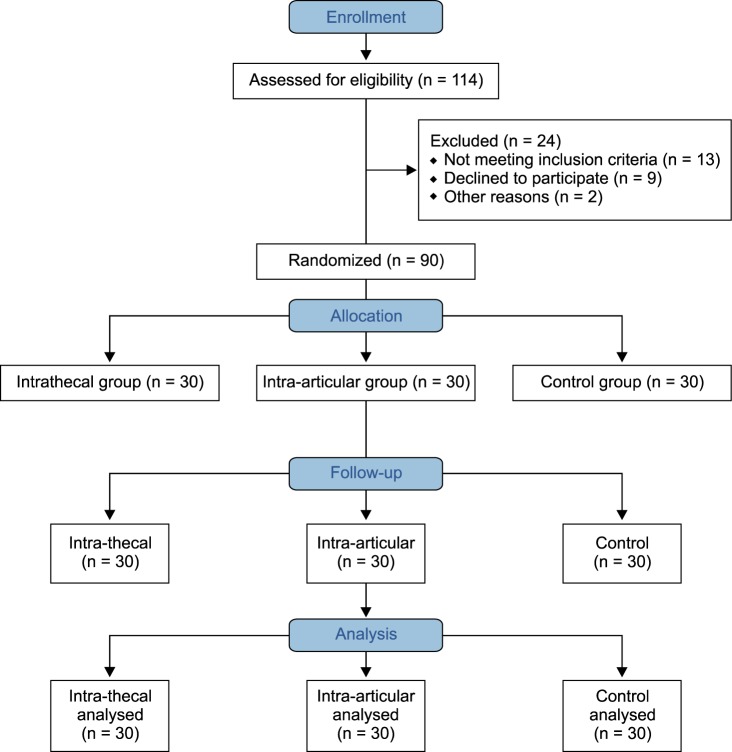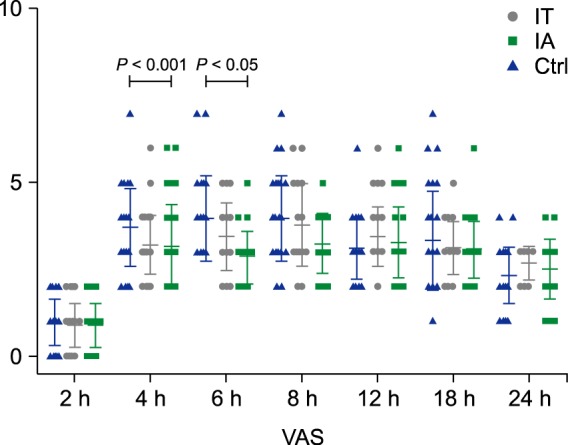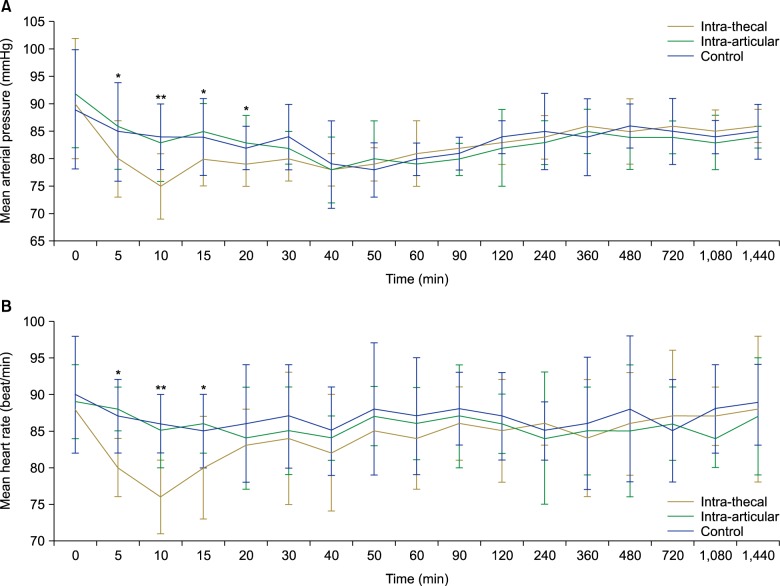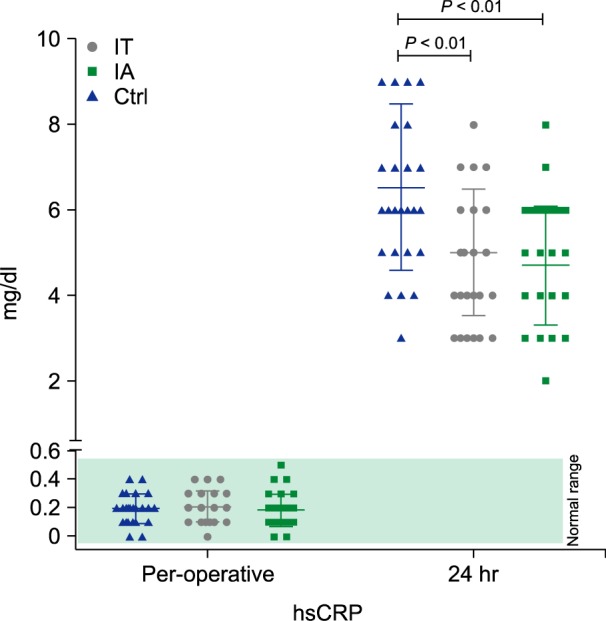Korean J Pain.
2017 Apr;30(2):134-141. 10.3344/kjp.2017.30.2.134.
Comparison of intrathecal versus intra-articular dexmedetomidine as an adjuvant to bupivacaine on postoperative pain following knee arthroscopy: a randomized clinical trial
- Affiliations
-
- 1Department of Anesthesia, Faculty of Medicine, Assiut University, Assiut, Egypt. mhbakri@gmail.com
- 2Department of Clinical Pathology, Faculty of Medicine, Menoufia University, Shebin Elkom, Egypt.
- KMID: 2376049
- DOI: http://doi.org/10.3344/kjp.2017.30.2.134
Abstract
- BACKGROUND
Postoperative pain is a common, distressing symptom following arthroscopic knee surgery. The aim of this study was to compare the potential analgesic effect of dexmedetomidine after intrathecal versus intra-articular administration following arthroscopic knee surgery.
METHODS
Ninety patients undergoing unilateral elective arthroscopic knee surgery were randomly assigned into three groups in a double-blind placebo controlled study. The intrathecal dexmedetomidine group (IT) received an intrathecal block with intrathecal dexmedetomidine, the intra-articular group (IA) received an intrathecal block and intra-articular dexmedetomidine, and the control group received an intrathecal block and intra-articular saline. The primary outcome of our study was postoperative pain as assessed by the visual analogue scale of pain (VAS). Secondary outcomes included the effect of dexmedetomidine on total postoperative analgesic use and time to the first analgesic request, hemodynamics, sedation, postoperative nausea and vomiting, patient satisfaction, and postoperative C-reactive protein (CRP) levels.
RESULTS
Dexmedetomidine administration decreased pain scores for 4 h in both the intrathecal and intra-articular groups, compared to only 2 h in the control patient group. Furthermore, there was a significant reduction in pain scores for 6 h in the intra-articular group. The time to the first postoperative analgesia request was longer in the intra-articular group compared to the intrathecal and control groups. The total meperidine requirement was significantly lower in the intra-articular and intrathecal groups than in the control group.
CONCLUSIONS
Both intrathecal and intra-articular dexmedetomidine enhanced postoperative analgesia after arthroscopic knee surgery. Less total meperidine was required with intra-articular administration to extend postoperative analgesia to 6 h with hemodynamic stability.
Keyword
MeSH Terms
Figure
Reference
-
1. Bondok RS, Abd El-Hady AM. Intra-articular magnesium is effective for postoperative analgesia in arthroscopic knee surgery. Br J Anaesth. 2006; 97:389–392. PMID: 16835255.
Article2. Abdallah FW, Dwyer T, Chan VW, Niazi AU, Ogilvie-Harris DJ, Oldfield S, et al. IV and Perineural dexmedetomidine similarly prolong the duration of analgesia after interscalene brachial plexus block: a randomized, three-arm, triple-masked, placebo-controlled trial. Anesthesiology. 2016; 124:683–695. PMID: 26649424.
Article3. Kanazi GE, Aouad MT, Jabbour-Khoury SI, Al Jazzar MD, Alameddine MM, Al-Yaman R, et al. Effect of low-dose dexmedetomidine or clonidine on the characteristics of bupivacaine spinal block. Acta Anaesthesiol Scand. 2006; 50:222–227. PMID: 16430546.
Article4. Al-Mustafa MM, Abu-Halaweh SA, Aloweidi AS, Murshidi MM, Ammari BA, Awwad ZM, et al. Effect of dexmedetomidine added to spinal bupivacaine for urological procedures. Saudi Med J. 2009; 30:365–370. PMID: 19271064.5. Al-Ghanem SM, Massad IM, Al-Mustafa MM, Al-Zaben KR, Qudaisat IY, Qatawneh AM, et al. Effect of adding dexmedetomidine versus fentanyl to intrathecal bupivacaine on spinal block characteristics in gynecological procedures: a double blind controlled study. Am J Appl Sci. 2009; 6:882–887.
Article6. Paul S, Bhattacharjee DP, Ghosh S, Dawn S, Chatterjee N. Efficacy of intra-articular dexmedetomidine for postoperative analgesia in arthroscopic knee surgery. Ceylon Med J. 2010; 55:111–115. PMID: 21341623.
Article7. Al-Metwalli RR, Mowafi HA, Ismail SA, Siddiqui AK, Al-Ghamdi AM, Shafi MA, et al. Effect of intra-articular dexmedetomidine on postoperative analgesia after arthroscopic knee surgery. Br J Anaesth. 2008; 101:395–399. PMID: 18567675.
Article8. Manuar MB, Majumdar S, Das A, Hajra BK, Dutta S, Mukherjee D, et al. Pain relief after arthroscopic knee surgery: a comparison of intra-articular ropivacaine, fentanyl, and dexmedetomidine: a prospective, double-blinded, randomized controlled study. Saudi J Anaesth. 2014; 8:233–237. PMID: 24843339.
Article9. Vanderstappen C, Verhoeven N, Stuyck J, Bellemans J. Intra-articular versus serum C-reactive protein analysis in suspected periprosthetic knee joint infection. Acta Orthop Belg. 2013; 79:326–330. PMID: 23926737.10. Bekker A, Haile M, Kline R, Didehvar S, Babu R, Martiniuk F, et al. The effect of intraoperative infusion of dexmedetomidine on the quality of recovery after major spinal surgery. J Neurosurg Anesthesiol. 2013; 25:16–24. PMID: 22824921.
Article11. Parker MJ, Manan A, Duffett M. Rapid, easy, and cheap randomization: prospective evaluation in a study cohort. Trials. 2012; 13:90. PMID: 22726309.
Article12. Black AS, Newcombe GN, Plummer JL, McLeod DH, Martin DK. Spinal anaesthesia for ambulatory arthroscopic surgery of the knee: a comparison of low-dose prilocaine and fentanyl with bupivacaine and fentanyl. Br J Anaesth. 2011; 106:183–188. PMID: 20947591.
Article13. Ramsay MA, Savege TM, Simpson BR, Goodwin R. Controlled sedation with alphaxalone-alphadolone. Br Med J. 1974; 2:656–659. PMID: 4835444.
Article14. Rifai N, Tracy RP, Ridker PM. Clinical efficacy of an automated high-sensitivity C-reactive protein assay. Clin Chem. 1999; 45:2136–2141. PMID: 10585345.
Article15. Hamwi A, Vukovich T, Wagner O, Rumpold H, Spies R, Stich M, et al. Evaluation of turbidimetric high-sensitivity C-reactive protein assays for cardiovascular risk estimation. Clin Chem. 2001; 47:2044–2046. PMID: 11673378.
Article16. Wang SS, Hu SW, Zhang QH, Xia AX, Jiang ZX, Chen XM. Mesenchymal stem cells stabilize atherosclerotic vulnerable plaque by anti-inflammatory properties. PLoS One. 2015; 10:e0136026. PMID: 26288013.
Article17. Dupont WD, Plummer WD Jr. Power and sample size calculations for studies involving linear regression. Control Clin Trials. 1998; 19:589–601. PMID: 9875838.
Article18. Hayashi Y, Maze M. Alpha 2 adrenoceptor agonists and anaesthesia. Br J Anaesth. 1993; 71:108–118. PMID: 8102063.
Article19. Niu XY, Ding XB, Guo T, Chen MH, Fu SK, Li Q. Effects of intravenous and intrathecal dexmedetomidine in spinal anesthesia: a meta-analysis. CNS Neurosci Ther. 2013; 19:897–904. PMID: 24118775.
Article20. Mohamed AA, Fares KM, Mohamed SA. Efficacy of intrathecally administered dexmedetomidine versus dexmedetomidine with fentanyl in patients undergoing major abdominal cancer surgery. Pain Physician. 2012; 15:339–348. PMID: 22828688.21. De Kock M, Gautier P, Fanard L, Hody JL, Lavand'homme P. Intrathecal ropivacaine and clonidine for ambulatory knee arthroscopy: a dose-response study. Anesthesiology. 2001; 94:574–578. PMID: 11379675.22. Eisenach JC, De Kock M, Klimscha W. Alpha(2)-adrenergic agonists for regional anesthesia. A clinical review of clonidine (1984-1995). Anesthesiology. 1996; 85:655–674. PMID: 8853097.23. Nakamura M, Ferreira SH. Peripheral analgesic action of clonidine: mediation by release of endogenous enkephalin-like substances. Eur J Pharmacol. 1988; 146:223–228. PMID: 3163552.
Article24. Khan AL, Singh RB, Tripathi RK, Choubey S. A comparative study between intrathecal dexmedetomidine and fentanyl as adjuvant to intrathecal bupivacaine in lower abdominal surgeries: a randomized trial. Anesth Essays Res. 2015; 9:139–148. PMID: 26417118.
Article25. Gupta R, Verma R, Bogra J, Kohli M, Raman R, Kushwaha JK. A comparative study of intrathecal dexmedetomidine and fentanyl as adjuvants to bupivacaine. J Anaesthesiol Clin Pharmacol. 2011; 27:339–343. PMID: 21897504.
Article26. Liang X, Zhou M, Feng JJ, Wu L, Fang SP, Ge XY, et al. Efficacy of dexmedetomidine on postoperative nausea and vomiting: a meta-analysis of randomized controlled trials. Int J Clin Exp Med. 2015; 8:12113–12134. PMID: 26550123.
- Full Text Links
- Actions
-
Cited
- CITED
-
- Close
- Share
- Similar articles
-
- Comparison of Intra-Articular Bupivacaine and Morphine for Pain Relief after Knee Arthroscopy
- Comparison of the Analgesic Effect between Bupivacaine and Morphine by Intra- articular Infiltration after Arthroscopic Knee Surgery
- Intra-articular Morphine, Bupivacaine-Morphine for Pain Relief after Arthroscopy Surgery of the Knee Joint
- Knee arthroscopy under intraarticular injection of bupivacaine
- The Analgesic Effect of Intraarticular Bupivacaine and Morphine after Arthroscopic Knee Surgery





